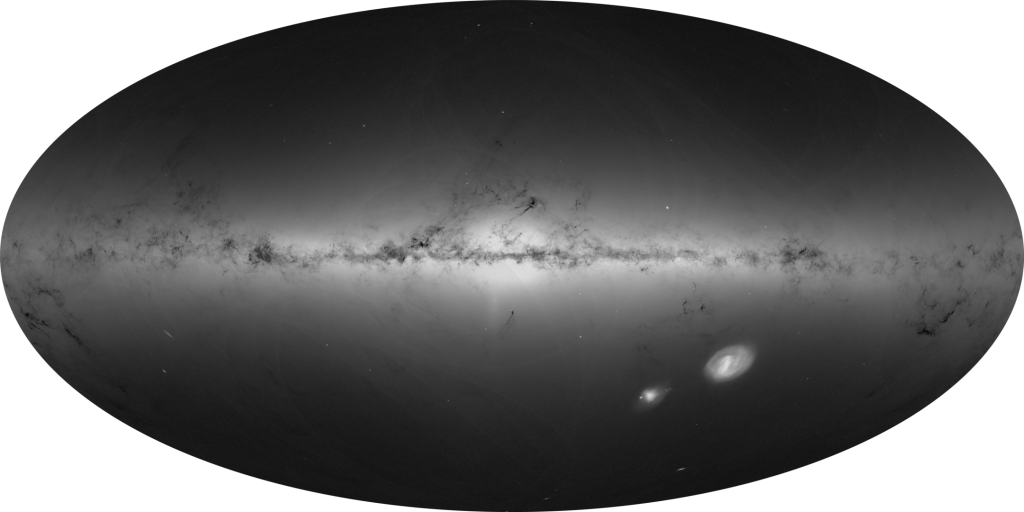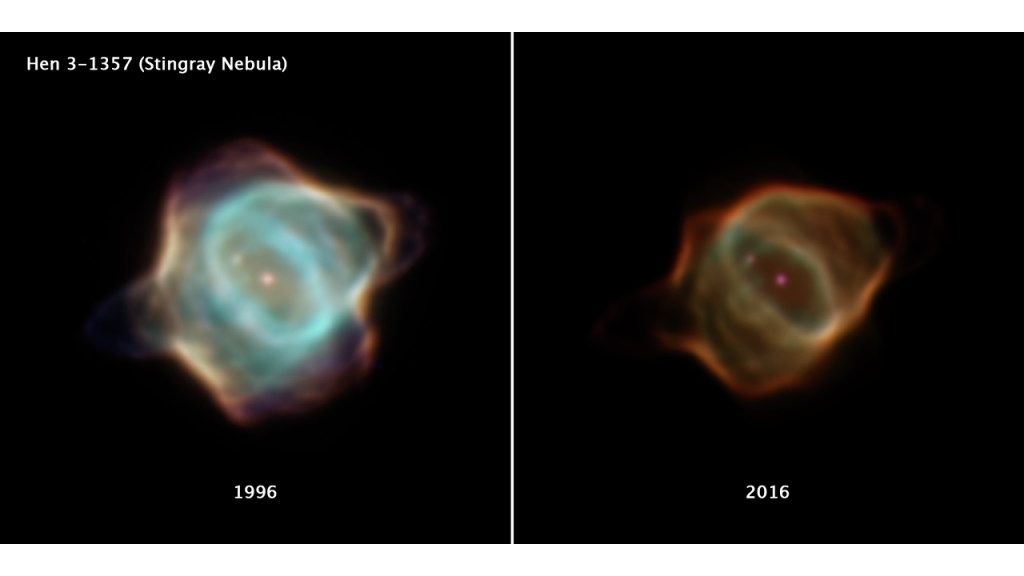Media
Summary
The release of the Gaia space telescope’s Early Data Release 3 has paved the way for a 3D map of the Milky Way, a glimpse at its history, and the acceleration of our own solar system. Plus, Alaskan volcanoes, the Stingray Nebula fades, and yes, that really was a Centaur rocket booster captured by the Earth. And we announce our first CosmoQuest Book Club selection!
Transcript
This is the Daily Space for today, Friday, December 4, 2020. I am your host, Dr. Pamela Gay.
And I am your host, Beth Johnson.
And we are here to put science in your brain.
Today we have news of a torrential downpour of data from the Gaia mission. This amazing mission has just posted an early version of its data release 3 catalog. The finalized version will come out in spring 2022, but this interim release has enough content to keep everyone busy until then.
This release contains:
- 1.8 billion stellar positions
- 1.5 billion stellar colors
- 1.5 billion stellar parallax and proper motion measurements
- 1.6 million extragalactic sources

This kind of data allows us to precisely answer questions about where we are, what is around us, and where all of it is going over time.
Over the next few weeks, we expect a deluge of papers. One of my favorite phenomena with Gaia data is the automated paper. There are folks out there who know that specific questions can be answered with the data and have their software ready to mine the data, find the results, and essentially plug the results into a pre-written paper using software that has “if this value, then this paragraph” coded in.
Already there is cool science being written. For instance, this data precisely measures our solar system’s motion in relation to distant quasars, and using this data, researchers could calculate the acceleration our solar system experiences from the gravity of our galaxy – this is the F=ma acceleration that determines our orbit. The number is small – just two one-hundred-billionth parts of the gravitational acceleration caused by the Earth on its surface – but it is the kind of data that allows other research to be done.
Stay tuned, the data has arrived and the science will follow.
It’s not often I bring you right back to Earth for some local planetary science, but I get to do that today. We don’t just study volcanoes in space, y’all.
In Alaska, there is a group of six stratovolcanoes on the ironically named Islands of the Four Mountains. These volcanoes are steep-sided and tall, like most stratovolcanoes, and now it seems they may be connected and part of one large underground caldera. As opposed to a mountain, a caldera volcano is a huge pool of magma that can cause the biggest, most destructive eruptions. The most famous is Yellowstone, also here in the United States.

CREDIT: John Lyons/USGS.
Per the press release: Unlike stratovolcanoes, which tend to tap small- to modestly-sized reservoirs of magma, a caldera is created by tapping a huge reservoir in the Earth’s crust. When the reservoir’s pressure exceeds the strength of the crust, gigantic amounts of lava and ash are released in a catastrophic episode of eruption.
The Islands of the Four Mountains are in the Aleutian island arc that reaches from the coast of Alaska out into the Pacific Ocean. It’s formed like most island arcs on Earth, where one plate subducts, or sinks, under another. In this case, the Pacific Plate is subducting under the North American Plate, giving rise to a long, curved chain of volcanoes.
The press release goes on to explain: Caldera-forming eruptions are the most explosive volcanic eruptions on Earth and they often have had global effects. The ash and gas they put into the atmosphere can affect Earth’s climate and trigger social upheaval. For example, the eruption of nearby Okmok volcano in the year BCE 43 has been recently implicated in the disruption of the Roman Republic. The proposed caldera underlying the Islands of the Four Mountains would be even larger than Okmok.
Now, this theory is by no means certain, and the scientists involved want to go to the Islands and take direct samples of the rocks to match chemical compositions and gather seismic data. This research was done using bathymetry only – depth soundings collected last century. The results will be presented on Monday at the American Geophysical Union’s Fall Meeting.
I, for one, am excited to hear about these results.
From the changing Earth, we now turn to the changing sky. One of the not-often-discussed justifications for building the Hubble Space Telescope was its ability to resolve the structure of planetary nebulae. These often geometric structures surround dead and dying stars and are formed when those stars puff off the outer layers of their atmosphere. Most of the planetary nebulae we study are fairly old and unchanging as they glow faintly around a white dwarf in their core.
But most is not all. There is one notable exception: The Stingray Nebula, or more officially Hen 3-1357. In 1996, the central star underwent what is now thought to have been a short-lived Helium flash as it changed evolutionary stages, and with that flash, created a dramatic looking planetary nebula. When re-examined in 2016, Hubble found the system dramatically fainter and structurally changed. Where the shells of gas in nebulae are often seen to expand away from their origin, in this case, inner shells were seen to fall back toward the center. According to research team member Martin Guerrero: This is very, very dramatic, and very weird. What we’re witnessing is a nebula’s evolution in real-time. In a span of years, we see variations in the nebula. We have not seen that before with the clarity we get with this view.

This work is detailed in a new paper in The Astrophysical Journal with first author Bruce Balick, who points out: In most studies, the nebula usually gets bigger. Here, it’s fundamentally changing its shape and getting fainter, and doing so on an unprecedented time scale. Moreover, to our surprise, it’s not growing any larger. Indeed, the once-bright inner elliptical ring seems to be shrinking as it fades.
This set of observations has captured a short-lived phenomenon driven by changes in the central star. What is amazing about this is Hubble caught the earliest moments of a planetary nebula, and now, for generations, humanity will get to watch as the star dies and the nebula is born.
Planetary nebula and nebulae. Astronomers really can’t be trusted to name things, and our next story is another example of that.
Back on November 13, we brought you a story that researchers using the Pan-STARRS1 survey telescope had discovered a new object known as 2020 SO and that it might be a long lost Centaur rocket booster from the 1960s. Well, scientists have now confirmed that this object is indeed that rocket booster.
A team from the Lunar and Planetary Laboratory at the University of Arizona used NASA’s Infrared Telescope Facility (IRTF) to get spectrum data of 2020 SO to compare to 301 stainless steel, which is what the Centaurs were made with. At first, the data were not a perfect match, and the discrepancy was thought to be due to the effects of space weather on the booster. So the team set out to observe another Centaur rocket booster known to be in orbit around Earth.

However, that’s not as easy as it first sounds. As team lead Vishnu Reddy said: Because of the extreme speed at which Earth-orbiting Centaur boosters travel across the sky, we knew it would be extremely difficult to lock on with the IRTF long enough to get a solid and reliable data set.
The team pulled off what seemed to be impossible on December 1, gathering spectrum data on a 1971 Centaur booster. A new comparison to the 2020 SO spectra was performed, and they were a definitive match.
Now, 2020 SO will not stay in orbit around Earth for very long. It’s expected to escape back out into a new solar orbit next March. Still, as Reddy pointed out: This conclusion was the result of a tremendous team effort. We were finally able to solve this mystery because of the great work of Pan-STARRS, Paul Chodas and the team at [Center for NEO Studies] CNEOS, [Large Binocular Telescope] LBT, IRTF, and the observations around the world.
So congrats to all involved. It’s nice to see something work this year.

Finally, we have one quick announcement. Our co-host, Annie Wilson, recently started a CosmoQuest book club over on Goodreads. She and I have since picked our inaugural selection for December, and it is Packing for Mars: The Curious Science of Life in the Void by Mary Roach. The cover blurb reads: “The best-selling author of Stiff and Bonk explores the irresistibly strange universe of space travel and life without gravity. From the Space Shuttle training toilet to a crash test of NASA’s new space capsule, Mary Roach takes us on the surreally entertaining trip into the science of life in space and space on Earth.”
Yup. Space toilet training. And now you know why Annie wants to read it first. We plan to review the book during Daily Space at the beginning of January, and we’ll have discussions over on Discord. Make sure to join both if you want to read along and chat. We’ll have all the links necessary in today’s show notes on DailySpace.org.
This has been the Daily Space.
Learn More
Gaia’s New Data Takes Us to the Milky Way’s Anticenter & Beyond
Cluster of Alaskan islands could be single, interconnected giant volcano
Hubble Captures Fading of the Stingray Nebula
- HEIC press release
- NASA Hubblesite press release
- “The Fall of the Youngest Planetary Nebula, Hen 3-1357,” Bruce Balick, Martín A. Guerrero & Gerardo Ramos-Larios, 2020, to appear in the Astrophysical Journal (preprint on arxiv.org)
New Data Confirm 2020 SO to Be the Upper Centaur Rocket Booster From the 1960s
Credits
Written by Pamela Gay and Beth Johnson
Hosted by Pamela Gay and Beth Johnson
Audio and Video Editing by Ally Pelphrey
Content Editing by Beth Johnson
Intro and Outro music by Kevin MacLeod, https://incompetech.com/music/


 We record most shows live, on Twitch. Follow us today to get alerts when we go live.
We record most shows live, on Twitch. Follow us today to get alerts when we go live.